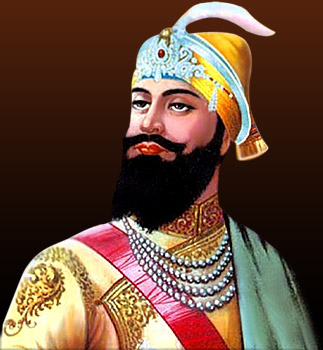 Khalsa was created by Guru Gobind Singh, the 10th Sikh Guru. The word "Khalsa" means `pure.` The Sikhs of the Khalsa undergo the sacred Amrit Ceremony. The Khalsa order was initially created on Baisakhi Day March 30 1699. Guru Gobind Singh baptized 5 Sikhs and then in turn asked the five Khalsa`s to baptize him. By doing this he brought perfect equality among the Sikhs. He was also instrumental in abolishing the out dated caste system. He gave much importance to the religious aspect just like the martial aspect. The disciples of Guru Gobind Singh were therefore called saint soldiers. The creation of Khalsa was an epoch making event in the religious and political history of the country. The creation of Khalsa marked the beginning of the rise of new people intended to act as heroes against all domination and tyranny. It was said that as soon as one joins the rank of the Khalsa all were regarded as equal. They were ready to provide help or any service to each in times of need. The Guru abolished the office of the masand and instituted the Khalsa on Baisakhi. As a true successor of Guru Nanak, Guru Gobind believed himself to have been chosen by God to establish the Panth of Nanak.
Khalsa was created by Guru Gobind Singh, the 10th Sikh Guru. The word "Khalsa" means `pure.` The Sikhs of the Khalsa undergo the sacred Amrit Ceremony. The Khalsa order was initially created on Baisakhi Day March 30 1699. Guru Gobind Singh baptized 5 Sikhs and then in turn asked the five Khalsa`s to baptize him. By doing this he brought perfect equality among the Sikhs. He was also instrumental in abolishing the out dated caste system. He gave much importance to the religious aspect just like the martial aspect. The disciples of Guru Gobind Singh were therefore called saint soldiers. The creation of Khalsa was an epoch making event in the religious and political history of the country. The creation of Khalsa marked the beginning of the rise of new people intended to act as heroes against all domination and tyranny. It was said that as soon as one joins the rank of the Khalsa all were regarded as equal. They were ready to provide help or any service to each in times of need. The Guru abolished the office of the masand and instituted the Khalsa on Baisakhi. As a true successor of Guru Nanak, Guru Gobind believed himself to have been chosen by God to establish the Panth of Nanak.
Guru Gobind Singh first tried to set his own house in order. The masands, who at one time, were the representative agents of the Guru, were an important link between the Guru and a large number of his Sikhs. The organization of the Sikh Panth greatly depended on the performance of their duties by the masands. However, the Guru later appointed new agents to establish a direct connection with the Sikhs. The Guru issued hukamnamas to the Sikh sangats after the Baisakhi of 1699. In it they were asked to send their offerings directly to the Guru through authorized persons or to bring these personally to Anandpur. Earlier during the time of Guru Har Gobind the Sikhs who were directly related to the Guru`s household and remained his permanent companions were called his Khalsa. The sangat of the East was called the Khalsa of Guru Har Gobind. Likewise, the sangat at Pattan was called the Khalsa of Guru Tegh Bahadur and the sangat of Machhiwara was called the Khalsa of Guru Gobind Singh even before the Baisakhi of 1699. On the Baisakhi day of 1699 the sangats were invited in large numbers. The Guru gave a soul stirring speech and asked five people to come forward who would be willing to lay down their lives for dharma. The first man was a Khatri from Lahore, the second was a Jat from Delhi, the third was a washerman from Dwarka, the fourth was a cook from Jagannath, and the fifth was a barber from Bidar. Each of them represented five different regions of the country. The Guru gave them fine clothes to wear and initiated them into Khalsa Panth by giving them khandah-ki-pahul, i.e. sugared water stirred with a double edged khanda, and consecrated by recitation of the Gurbani. He called them as five beloved ones i.e. the Panj Piaras. Guru Gobind Singh himself took pahul from each of them thus merging his person with the persons of his disciples. He created `an Order of the Purified Ones (The Khalsa) of the wonderful Lord` who were to have faith in the Supreme Being and in none else.
Initiation Ceremony of Khalsa
 The Sikhs who joined the Khalsa had to undergo an initiation ceremony. It was known as the `baptism of the sword` (khand-ki pahul). The Baptism of the sword was asserted to arm the men and infuse in them `esprit de corps`. It was also done to completely change their state of mind, to transform their psychology towards life and also to change their attitude towards their fellow beings. They were trained to be prepared to give their life for the protection of the society, love and service of humanity. They needed to be ready to fight against tyranny whenever and wherever it became overt and intolerable. They were enjoined to preserve the corporate life of the community called the Panth. The highest ideal which the Guru placed before them was that they should merge themselves completely in the Guru. Accordingly, they were required to take four principal vows:
The Sikhs who joined the Khalsa had to undergo an initiation ceremony. It was known as the `baptism of the sword` (khand-ki pahul). The Baptism of the sword was asserted to arm the men and infuse in them `esprit de corps`. It was also done to completely change their state of mind, to transform their psychology towards life and also to change their attitude towards their fellow beings. They were trained to be prepared to give their life for the protection of the society, love and service of humanity. They needed to be ready to fight against tyranny whenever and wherever it became overt and intolerable. They were enjoined to preserve the corporate life of the community called the Panth. The highest ideal which the Guru placed before them was that they should merge themselves completely in the Guru. Accordingly, they were required to take four principal vows:
* They will have no pride of their occupation or position. It was known as the kritnash vow.
* They will have no pride of high birth, etc. this is known as the kulnash vow.
* They will discard all superstitions and traditional beliefs in the false Manna, rituals, etc. this is known as dharmnash vow.
* They will discard all old social customs and practices and train their lives according to the injunctions of the Guru. This is known as the ritinash karmnash vow.
The Khalsa thus stood as a distinguished organization from the rest of the world. After the five beloved ones baptized the Guru, the principle that emerged was that any five baptized Sikhs could initiate novice Sikhs into the Khalsa. Thus the Khalsa became the Guru and the Guru became the Khalsa.









